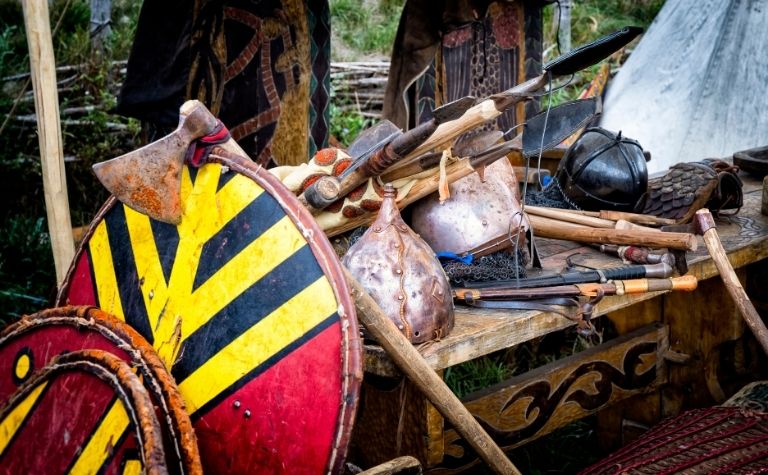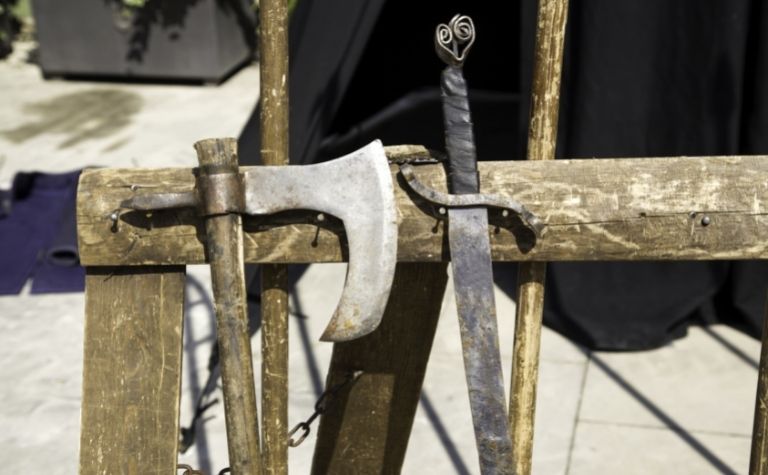During their brief but world-changing dominance in Northern Europe during the two-and-a-half centuries known as the Viking Age, the warrior Norsemen from Scandinavia wreaked havoc and instilled fear among those who stood in their path.
While their courage and fighting spirit are legendary, the Vikings also utilized weapons that fit their combat techniques to a tee.
The noble sword is the poster child of Viking weaponry, but few warriors could afford one.
The Vikings may have even employed one of the most feared weapons of the Middle Ages. Most Vikings fought with weapons that were far more attainable, including:
- Axes
- Bows and arrows
- Knives
- Spears
- Shields
Sailing over long distances in their iconic longships, the Vikings set their sights on distant shores in their quest for wealth, power, and new lands to settle.
In so doing, they engaged in fierce battles, often fighting in close quarters with weapons geared toward this type of combat.
Read on to learn about the weapons used by the Vikings to achieve historic dominance, starting with their beloved swords.

Viking Swords
Of all the weapons in the Vikings’ arsenal, their swords have garnered the most attention.
They wreaked havoc on the battlefield but also served as status symbols given the high cost and specialized skill involved in their fabrication.
So attached were those Vikings fortunate enough to own swords that it was not uncommon for them to give names to these prestigious weapons. (Also see Is Valhalla Heaven or Hell? Facts That Might Surprise You)
In addition, because of their tremendous worth not just in battle but as family heirlooms, swords were either passed down from one generation to the next or buried in their owners’ graves. [1]
Sometimes, they were left as sacrifices to the Norse gods. (Also see 25 Norse Gods to Know)
Early Viking swords were single-edged but later evolved into a double-edged form that became the most common type. Other attributes of these cherished weapons included:
- The blades of Viking swords were crafted from iron
- Entire swords (the blade plus the hilt and pommel) were typically 3 feet (90 cm) in length
- Some blades featured a groove (known as a “fuller”) running the entire length along the center to make them lighter to handle
- Sword hilts varied in construction from simple antler handles to elaborate grips fashioned from precious metals like gold or silver
- Pommels made from iron or copper alloy were often attached to the end of the hilts to act as counterweights to the blade and produce a balanced sword [2]
Even in modern times, centuries after the last Viking raid, the discovery of intact swords in Viking burial sites throughout Scandinavia and Northern Europe represents the holy grail of Norse artifacts, and only adds to the mystique of the most recognizable weapon in the Viking armory. (Also see Can You Buy Genuine Viking Artifacts Today?)

Viking Shields
While they undoubtedly served primarily defensive purposes, in the hands of skilled warriors, Viking shields could also be utilized as offensive weapons.
Unlike the larger, heavier shields used elsewhere in Europe during the Middle Ages, Viking shields were lightweight and designed with different objectives in mind. (Also see The Viking Shield: The Meaning of the Shape, Color, and Patterns)
Some of the unique design aspects of Viking shields include:
- Vikings shields were made from wood, often pine, fir, or alder, and cut into a circular shape
- The typical shield was 30 to 32 inches (around 80 cm) in diameter
- Unlike other European shields which were held by straps fitted around the forearm, Viking shields were held from the center by gripping a bar stretching across an opening with the hand
- To protect the shield-bearer’s hand, an iron dome (known as a “boss”) was placed over the center hole where the grip bar was fastened [3]
Rather than blocking direct blows from opponents’ armament, Viking shields were intended to deflect or absorb the force of weapon strikes.
Enemy blades could become embedded in the wood planks and the shield-bearer could wrestle weapons away. [4]
Savvy Vikings used their highly maneuverable shields as an extension of their arm, striking their enemies with the metal bosses in the center of the shields.
Viking shields could also be used to jam enemy soldiers in close quarters and knock them off balance, allowing their bearers to strike at opponents in compromised positions. [5] (Also see What Did the Vikings Really Look Like?)
Viking Axes
While their swords may have been the glamour weapon in their arsenal, the humble axe is likely the one that won battles for the Vikings.
Axes were a common sight throughout Scandinavia during the Viking Age (and even long prior) as they were multi-functional tools that were useful around the farm, on the homestead, and even to build the iconic longships that ferried warriors to distant battlefields. [6]
It was in combat that Viking axes earned their well-deserved reputation as a devastating weapon capable of producing deadly results. [7] (Also see the full article Why Are Vikings Associated with Axes?)
Since only their heads were made from iron, Viking axes were far less expensive to make, and therefore, more warriors had access to them.
In a pinch, the same axe used to chop wood could be used in battle. And being relatively lightweight, axes were a versatile weapon.
There were two primary types of axes used by the Vikings in warfare:
- The Dane axe had a large head with a lengthy shaft and was wielded with two hands, which made it a feared weapon that was capable of annihilating enemy forces
- The Bearded axe featured an elongated bit that extended far below the butt, like a beard, not only resulting in a longer cutting edge but also a hook of sorts that could grapple an enemy’s weapon and wrestle it away [8]
Despite their simple design and utilitarian appearance, Viking axes were all business on the battlefield and among the deadliest of Viking weapons. (Also see Did Vikings Have to Die with Sword in Hand to Reach Valhalla?)
Viking Bows and Arrows
Aside from their prowess with weapons like swords and axes, the Vikings were also highly skilled archers.
Initially implements for hunting wild game, bows, and arrows proved to be instrumental in battle, particularly against large enemy forces, with attributes such as:
- Arrows could travel astonishing distances, covering more than 600 feet (200 meters)
- A volley of arrows launched from afar by Viking archers could wipe out the front ranks of enemy forces
- Some Viking arrows had tips that could pierce armor [9]
Materials Used to Make Viking Bows and Arrows
As far as their construction, the materials that were used to make bows and arrows included:
- Bows were made from wood including yew, ash, and elm
- Arrow tips were fashioned from materials including metal (iron), wood, and the bones and horns from animals
Since it was not uncommon for bows and arrows to break, the Vikings relied on materials that were readily available to them.
Viking Knives
Life in medieval Scandinavia during the Viking Age was a difficult existence that consisted of a daily struggle against challenging elements and conditions.
As a sign of the times, one indispensable item which even slaves were known to carry, was a knife.
A simple single-edged blade known as a Knifr likely served countless purposes in everyday Viking life. [10]
When it came to combat, a larger knife was needed, and the Seax served this purpose more than suitably.
The typical characteristics of a Seax were:
- A heavy, single-edged blade
- A blade length ranging from 12 to 24 inches long (30 to 60 cm)
- A hilt fashioned from materials including wood, bone, animal horn [11]
Despite their smaller stature, Viking knives played an enormous role in Viking warfare.
Viking Spears
More so than even axes and knives, Viking spears were weapons for the common man.
They were also incredibly versatile and could be fashioned for different purposes. For example:
- Spear lengths varied from 3 to 10 feet in length (1 to 3 meters)
- Some spears were designed for thrusting enemy forces at close range
- Other spears were meant to be hurled over long distances [12]
As a testament to the significance of spears in the Viking arsenal, the most famous spear of all, Gungnir, was the trusted weapon of none other than Odin the all-father of Norse gods. [13]
Crafted by dwarves and imbued with magical attributes, Gungnir reputedly never missed its intended target.
During the war between the Aesir and Vanir gods, Odin launched his mighty spear over the ranks of the enemy as an intimidation tactic, and Viking warriors mimicked this act prior to engaging opposing forces.
Viking Siege Weapons
Interestingly, Viking combat techniques and warfare strategies were not limited to hand-held weapons and fighting in close quarters.
By some historical accounts, Norse invaders utilized siege weapons to break through defenses during their siege on Paris in 885, including battering rams and even catapults. [14]
Conclusion
Much of the success the Vikings experienced in battle can be attributed to the diverse and specialized weapons in their arsenal.
References:
[1] Source
[2] Source
[3] Source
[4] Source
[5] Source
[6] Source
[7] Source
[8] Source
[9] Source
[10] Source
[11] Source
[12] Source
[13] Source
[14} Source
